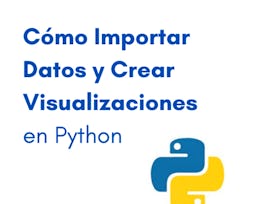En este curso, aprenderás cómo la Internet se puede convertir en una fuente de datos. Para esto, rasparemos, analizaremos y leeremos los datos web y también accederemos datos mediante APIs web. Trabajaremos con formatos de datos HTML, XML y JSON en Python. Este curso abarcará los capítulos 11-13 del libro de texto "Python for Everybody". Para tener éxito en este curso, debes estar familiarizado con el material que se incluye en los capítulos 1-10 del libro de texto y los dos primeros cursos de esta especialización. Estos temas incluyen variables y expresiones, ejecución condicional (bucles, ramificación y try/except), funciones, estructuras de datos de Python (cadenas, listas, diccionarios y tuplas) y manipulación de archivos. Este curso abarca Python 3.



Uso de Python para Acceder a Datos Web

Dozent: Charles Russell Severance
3.518 bereits angemeldet
Bei  enthalten
enthalten
Was Sie lernen werden
Usar expresiones habituales para extraer datos de cadenas
Comprender los protocolos que usan los navegadores web para recuperar documentos y aplicaciones web
Recuperar datos de sitios web y APIs usando Python
Trabajar con datos XML (eXtensible Markup Language)
Kompetenzen, die Sie erwerben
- Kategorie: Xml
- Kategorie: Application Programming Interfaces (API)
- Kategorie: Regular Expression (REGEX)
- Kategorie: Web
Wichtige Details

Zu Ihrem LinkedIn-Profil hinzufügen
5 Aufgaben
Erfahren Sie, wie Mitarbeiter führender Unternehmen gefragte Kompetenzen erwerben.


Erwerben Sie ein Karrierezertifikat.
Fügen Sie diese Qualifikation zur Ihrem LinkedIn-Profil oder Ihrem Lebenslauf hinzu.
Teilen Sie es in den sozialen Medien und in Ihrer Leistungsbeurteilung.

In diesem Kurs gibt es 6 Module
En esta sección, instalarás Python y un editor de texto. En las clases anteriores de la especialización, esta fue una tarea opcional, pero en esta clase es el primer requisito para comenzar. A partir de este momento, dejaremos de usar el ambiente de calificación Python basado en un navegador ya que el ambiente de Python basado en un navegador (Skulpt) no es capaz de ejecutar los programas más complejos que desarrollaremos en esta clase.
Das ist alles enthalten
6 Videos5 Lektüren2 App-Elemente
Las expresiones habituales son un lenguaje muy especializado que nos permite buscar brevemente cadenas y extraer datos de cadenas. Las expresiones habituales son un lenguaje en sí mismas. No es esencial saber usar expresiones habituales pero pueden ser bastante útiles y poderosas.
Das ist alles enthalten
4 Videos1 Lektüre1 Aufgabe1 App-Element
En esta sección aprendemos sobre los protocolos que utilizan los navegadores web para recuperar documentos y aplicaciones web para interactuar con las interfaces de programas de aplicaciones (API).
Das ist alles enthalten
8 Videos1 Lektüre1 Aufgabe1 App-Element
En esta sección aprendemos a usar Python para recuperar datos de sitios web y API a través de Internet.
Das ist alles enthalten
8 Videos1 Lektüre1 Aufgabe2 App-Elemente
En esta sección, aprendemos cómo recuperar y analizar datos XML (eXtensible Markup Language).
Das ist alles enthalten
8 Videos1 Aufgabe1 App-Element
En este módulo, trabajamos con interfaces de programas de aplicaciones/servicios web utilizando el formato de datos Notación de objetos JavaScript (JSON).
Das ist alles enthalten
12 Videos3 Lektüren1 Aufgabe2 App-Elemente
Dozent

Empfohlen, wenn Sie sich für Software Development interessieren

Coursera Project Network

Universidad Nacional Autónoma de México

Coursera Project Network
Warum entscheiden sich Menschen für Coursera für ihre Karriere?





Neue Karrieremöglichkeiten mit Coursera Plus
Unbegrenzter Zugang zu 10,000+ Weltklasse-Kursen, praktischen Projekten und berufsqualifizierenden Zertifikatsprogrammen - alles in Ihrem Abonnement enthalten
Bringen Sie Ihre Karriere mit einem Online-Abschluss voran.
Erwerben Sie einen Abschluss von erstklassigen Universitäten – 100 % online
Schließen Sie sich mehr als 3.400 Unternehmen in aller Welt an, die sich für Coursera for Business entschieden haben.
Schulen Sie Ihre Mitarbeiter*innen, um sich in der digitalen Wirtschaft zu behaupten.
Häufig gestellte Fragen
Access to lectures and assignments depends on your type of enrollment. If you take a course in audit mode, you will be able to see most course materials for free. To access graded assignments and to earn a Certificate, you will need to purchase the Certificate experience, during or after your audit. If you don't see the audit option:
The course may not offer an audit option. You can try a Free Trial instead, or apply for Financial Aid.
The course may offer 'Full Course, No Certificate' instead. This option lets you see all course materials, submit required assessments, and get a final grade. This also means that you will not be able to purchase a Certificate experience.
When you purchase a Certificate you get access to all course materials, including graded assignments. Upon completing the course, your electronic Certificate will be added to your Accomplishments page - from there, you can print your Certificate or add it to your LinkedIn profile. If you only want to read and view the course content, you can audit the course for free.
You will be eligible for a full refund until two weeks after your payment date, or (for courses that have just launched) until two weeks after the first session of the course begins, whichever is later. You cannot receive a refund once you’ve earned a Course Certificate, even if you complete the course within the two-week refund period. See our full refund policy.


